Signal Joining Rings
Contents
- 1 Overview
- 2 Exceptions
- 3 Visual Identification Guide
- 4 Carriage Rings Described by Type
- 4.1 3M Body Clip
- 4.2 Delta Hole
- 4.3 Fan Blade, Clipped Webbings
- 4.4 Fan Blade, Round Webbings
- 4.5 GE Canada Bolt
- 4.6 GE Streamline
- 4.7 Mickey Mouse Shaped, Large Circles
- 4.8 Mickey Mouse Shaped, Oval Bolt Holes
- 4.9 Mickey Mouse Shaped, Small Circles
- 4.10 Oversized, Oval Center Hole
- 4.11 Plastic Shoulder Washer
- 4.12 Round Center, Carriage Only
- 4.13 Round Center, Through-Hole
- 4.14 Serrated Plastic Bolt
Overview
Signal joining rings are known by different names depending on the signal equipment manufacturer. The most common trade name might be carriage ring or tri-bolt washer. [Insert some other names from various manufacturers.] All of these names and hardware are interchangeable. Brought about during the post WWII advent of modular, closed body signal construction, these are the unified flat washers that, along with typically three carriage bolts, join two traffic signal aspects together via the unused pipe mount bosses. This replaced the much less adaptive, sealed, or repairable design of open body signal sections held together with a single set of endplates and tie-rods. When the modular body sections were keyed for serrated locking rings on both top and bottom of the signal aspect it was also possible to create “twisted” signal designs wherein each lens does not need to point in the same direction, they are free to rotate 360° about the mounting axis.
Exceptions
There were a few notable exceptions to the use of carriage rings in closed body signal construction.
Marbelite
Most notably is the earlier body styles of Marbelite signals. Despite having the typical pipe boss and capable of using a tri-bolt ring the castings were molded with three drill out reliefs near the outer extremities of the signal. To assemble, one drilled these three holes on each signal, stacked them, then bolted them together with a bolt and square washer. While an elegant approach, and one could say more reliable, it was eventually eliminated for the common carriage ring design.
Crouse-Hinds
Another, rarer bird, is the rodded CH Type M (Breadpan.) For city specific requirements, this signal was constructed conventionally (with the tri-bolt washer) but available with each body section drilled and rods inserted through them all creating a belt-and-suspenders approach. This was perhaps less of a Luddite approach than it seemed. The Type-M body design did not have any serrations or other keying features on the top of the signal section, only the bottom. When stacking them, it was only the alignment and tightness of the bolts that would retain a signal aspect from rotation.
Visual Identification Guide
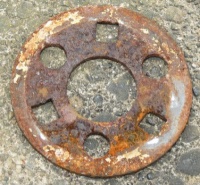
|
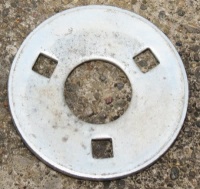
|
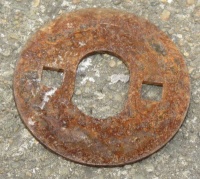
| |
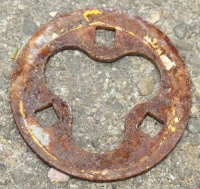
|
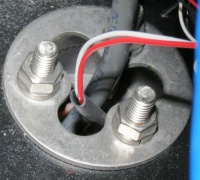
|
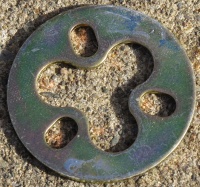
|
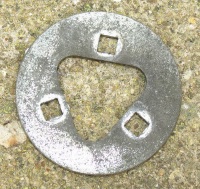
|
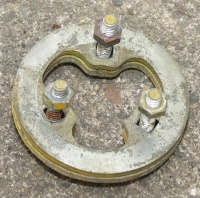
|
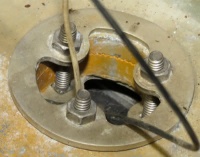
|
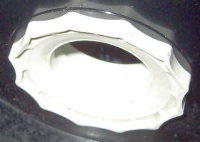
|
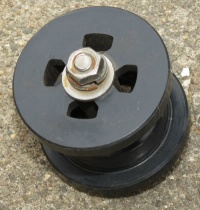
|
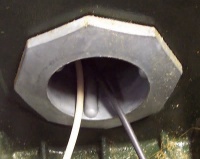
|
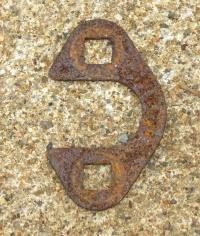
|
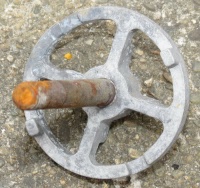
|
Carriage Rings Described by Type
3M Body Clip
This ring, more of a C-clip with two carriage holes, is commonly used to bolt together the iconic 3M PV signal. A 3M factory part, and an unusual size and shape limit its usability on standard traffic heads.
Signals used on:
3M
- M-131
- M-131R
- M-132
- M-133
Delta Hole
This is a conventional carriage ring, three carriage bolt holes, except the center hole is a rounded equilateral triangle. It does not seem to be very common and may be a rare early example used exclusively by Crouse-Hinds
Signals used on:
Crouse-Hinds (CH)
- 12-8-8 Deco-M Signals Circa 1964
Fan Blade, Clipped Webbings
The center hole is three connected oval holes making a larger Y-hole - the connection between the three holes has clipped, instead of curved flowing, webbed edges. More of a radiation alert symbol. There are three square carriage bolt holes.
Signals used on:
Eagle
- Flatback, 12"
- Flatback, 8", Non Trapezoid
- Flatback Ped, 9", Non Trapezoid
Fan Blade, Round Webbings
The center hole is three connected oval holes making a larger Y-hole - the connection between the three holes has smooth curved flowing, edges. More of a radiation alert symbol. There are three square carriage bolt holes.
Signals used on:
Eagle
- Alusig, 8"
GE Canada Bolt
An aluminum hollow, fine thread 1 1/2" octagonal "bolt" with an octagonal jam nut.
Signals used on:
General Electric (GE) [of Canada]
- Econolite Style Body, Stamped Aluminum Reflectors, GE Canada Logo
GE Streamline
A cast spoked wheel design that is toothed to lock into the signal body as well as another ring. It only uses a central through-bolt for connections. This ring keeps all signal faces at 0° or 180° alignment.
Signals used on:
General Electric (GE)
- Streamline
Mickey Mouse Shaped, Large Circles
The center hole is three connected [round] holes making a larger Y-hole. Rather like a Mickey Mouse with a tiny head. There are three square carriage bolt holes.
Signals used on:
Crouse-Hinds (CH)
- Type-M, Ped
- Type-R, 8"
- Type-R, 9" Ped
- Type-R, 12"
Traffic Control Technologies (TCT)
- Crouse-Hinds Type-R Style, 12"
Winko-Matic (WM)
- 8" Aluminum Signal
- 12" Aluminum Signal
Mickey Mouse Shaped, Oval Bolt Holes
This is a carriage ring provided with Pelco hardware. The carriage bolt holes are slotted allowing for flexibility when used with signals of varying mounting hole diameters.
Signals used on:
None
Mickey Mouse Shaped, Small Circles
The center hole is three connected [round] holes making a larger Y-hole. Rather like a Mickey Mouse with a tiny head. There are three square carriage bolt holes.
This is the same as the large circle variant except the circles are noticeably smaller and the webbing more pronounced making a more distinct Y shape.
Signals used on:
Optisoft
- Programmable 12" Signal
Oversized, Oval Center Hole
This is a carriage washer provided by 3M for use in cases where a PV signal may join with conventional signal hardware or a conventional signal head. It only accepts two carriage bolts and has a distinct oval hole in the center. It is visibly larger than the "standard" size of a carriage ring.
Signals used on:
3M
- M-131
- M-131R
- M-132
- M-133
Plastic Shoulder Washer
It is a plastic fender washer shape, it has a central connector bolt hole surrounded by four pentagon shaped holes. Used in conjunction with only a single center bolt. Believed to be used with poly signals.
Signals used on:
Unknown
Round Center, Carriage Only
Likely the most common carriage ring, a simple center hole and three carriage bolt holes. Despite its commonality there is at least four unique variations of this washer.
Signals used on:
Eagle
- Mk.IV, 8"
Econolite
- Long/Short Groovebacks, 8"
- Bullseye, 12"
General Electric (GE)
- Grooveback, 8"
General Electric (GE) [of Canada]
- Grooveback, 8", Not Marked "Made in Canada"
Signal Computer Corp. (SCC)
- Checker Logo Signal, 8"
A1
- Aluminum Signal, Conventional Reflector, 8"
- Aluminum Signal, Door Reflector, 8"
Southern Autoflow
- Aluminum 8" Signal, Standard Body
Indicator Controls Corp. (ICC)
- Aluminum Signal, 8"
- Aluminum Signal, 12"
Econolite
- Grooveback, 9" Pedestrian
Econolite (Canada)
- Buttonback Signal, 8"
- Buttonback Signal, 12"
Eagle
- Flatback, Trapezoidal, 8"
Round Center, Through-Hole
A derivative of the simple round center hole variety this one features both carriage bolt holes and carriage bolt pass-through holes. On paper it provides an infinitesimally larger bearing surface for the nut andor lockwasher to press against when retaining the signal. In practical use this is of little benefit and was never widely adopted.
Signals used on:
Automatic Signal/Eagle Signal
- Mk.IV, 8"
Laboratory For Electronics (LFE)
- Aluminum Signal, 8"
- Aluminum Signal, 12"
Singer
- Aluminum Signal, 8"
- Aluminum Signal, 9" Pedestrian
Serrated Plastic Bolt
Available in white or black, it consists of a hollow male and female bolt that screw together through the mounting hole of the signal.
Signals used on:
Siemens [of Europe]
- Poly Signals